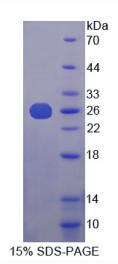
赫曼斯基普德拉克综合征蛋白4(HPS4)重组蛋白
产品名称: 赫曼斯基普德拉克综合征蛋白4(HPS4)重组蛋白
英文名称: Recombinant Hermansky Pudlak Syndrome Protein 4 (HPS4)
产品编号: YB598Mu013
产品价格: 0
产品产地: 中国/美国
品牌商标: 钰博生物/Ybscience
更新时间: 2023-08-17T10:29:50
使用范围: null
- 联系人 : 陈环环
- 地址 : 上海市沪闵路6088号龙之梦大厦8楼806室
- 邮编 : 200612
- 所在区域 : 上海
- 电话 : 183****2235 点击查看
- 传真 : 点击查看
- 邮箱 : shybio@126.com
- 二维码 : 点击查看
赫曼斯基普德拉克综合征蛋白4(HPS4)重组蛋白
YB598Mu013
Recombinant Hermansky Pudlak Syndrome Protein 4 (HPS4)
Organism Species: Mus musculus (Mouse)
Instruction manual
FOR IN VITRO USE AND RESEARCH USE ONLY
NOT FOR USE IN CLINICAL DIAGNOSTIC PROCEDURES
10th Edition (Revised in Jan, 2014)
赫曼斯基普德拉克综合征蛋白4(HPS4)重组蛋白[ PROPERTIES ]
Residues: Leu20~Leu214
Tags: Two N-terminal Tags, His-tag and T7-tag
Accession: Q99KG7
Host: E. coli
Purity: >90%
Endotoxin Level: <1.0EU per 1μg
(determined by the LAL method).
Formulation: Supplied as lyophilized form in 20mM Tris,
150mM NaCl, pH8.0, containing 1mM EDTA, 1mM DTT,
赫曼斯基普德拉克综合征蛋白4(HPS4)重组蛋白0.01% sarcosyl, 5% trehalose, and preservative.
Predicted isoelectric point: 7.7
Predicted Molecular Mass: 25.5kDa
Applications: SDS-PAGE; WB; ELISA; IP.
(May be suitable for use in other assays to be determined by the end user.)
[ USAGE ]
Reconstitute in sterile ddH2O.
[ STORAGE AND STABILITY ]
Storage: Avoid repeated freeze/thaw cycles.
Store at 2-8oC for one month.
Aliquot and store at -80oC for 12 months.
Stability Test: The thermal stability is described by the loss rate of the target
protein. The loss rate was determined by accelerated thermal degradation test,
that is, incubate the protein at 37oC for 48h, and no obvious degradation and
precipitation were observed. (Referring from China Biological Products Standard,
which was calculated by the Arrhenius equation.) The loss of this protein is less
than 5% within the expiration date under appropriate storage condition.
赫曼斯基普德拉克综合征蛋白4(HPS4)重组蛋白[ SEQUENCES ]
The sequence of the target protein is listed below.
L YDGSK VK GE G DPT RAGI CYF YPPQ T L L D Q QE L L CG Q LAGV VRC LW D LS GT
PPMLIRMRNL KFAIRADGDY LWALGCGVEISDASCRQFLD QLIGFFHFYM GPVSLAYKSH
PQEELSLQWD TSITQVLRSTSESHRIFNAL WNLDRTKVEP LLLLKAALIL QTCQRSPHVL
AGCILYKGLIVNSQLLPSLT AKVL
[ REFERENCES ]
1. Suzuki T., et al. (2002) Nat. Genet. 30:321-324.
2. McGarry M.P., et al. (1999) Proc. Soc. Exp. Biol. Med. 220:162-168.
3. Ko M.S.H., et al. (2000) Development 127:1737-1749.
4. Nguyen T., et al. (2002) J. Invest. Dermatol. 119:1156-1164.
